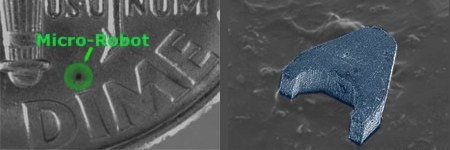
The Carnegie Mellon NanoRobotics Lab uses external magnetic fields to precisely control their nanosoccer players. The micro robots are just 300×300 micron specs of neodymium-iron-boron permanent magnets that have been laser machined. The working volume is surrounded by five electromagnetic coils. Four coils are used for position while the fifth provides clamping force to the work surface. The bot can be operated almost anywhere as long as the surface isn’t magnetically active. Machine vision is used to watch the bot and provide feedback control. Embedded below is the robot moving across a glass slide next to a dime. It can travel at speeds up to 60 body lengths per second.
nanosoccer2 Articles
Nanobot Nanosoccer
Medgadget recently published a post about a soccer competition for nanobots at RoboCup. The nanobots compete on a field that measures 1500 by 2500 micrometers with goals on the long sides jutting 500 micrometers out. Like normal soccer athletes, the nanobot teams attempt to push the ball – in this case, a silicon dioxide disc with a 50 micrometer diameter – into the goal. The nanobot competitors are monitored by an optical microscope and are remotely controlled by magnetic signals sent across the arena.
The National Institute of Standards and Technology (NIST) and RoboCup have already held two nanobot competitions in the last year. Nanobots made by different teams from various universities compete to test various abilities that will be critical for their practical applications in medicine, manufacturing, and other industries.
Though it is referred to as nanosoccer, the competition is actually a triathlon. The bots must sprint to the goal with the ball in one event, then maneuver the ball around stationary “defenders” and into the goal in the next event, and finally score as many goals as possible within 3 minutes. NIST and RoboCup hope to show the practical potential of nanobots with this competition and have a little fun in the process.
[via Medgadget]










